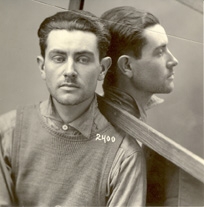
Paul Marsan Dornac Portrait of an unidentified writer 1890s (Albumen print, 25,8 x 20,2 cm)
Courtesy of Bassenge, Berlin (Photography, Sale: 90, Lot: 4047, Dec 5, 2007)
This is the first part of a series of short pieces that will examine collecting photographs. As these texts are refined they will be converted into illustrated articles on Luminous-Lint. I welcome all comments on how they can be improved.
There is an increasing amount of research into the question of why we collect and there are numerous books that explore the financial, socio-cultural, historical and psychological reasons. Susan Pearce, Emeritus Professor of Museum Studies at the University of Leicester in England has spent years examining these issues and uses the expression "the lust of the eye" which seems to be deeply within us and concerns our desire to place ourselves within a value framework. My aunt Madge described shopping as "looking for something to want" which also seems to be appropriate to our collecting quests. By collecting items we affirm our own aspirations in a physical form and these not only inspire us but also show others what we believe in and how we want to be seen. The research of Susan Pearce has shown that about 66% of respondents describe themselves as collectors and this seems to be true in most developed countries and may be a symptom of disposable income. There are gender issues here with women being more prone to display their collections in public areas of the house as they are more family based and men being prone to be more private in their interests.
The most commonly stated reasons for collecting include the following and each of us will have varying combinations of these.
- Learning - gaining knowledge and understanding
- Relaxation - being removed from the day-to-day stresses
- Pleasure - a personal association with objects of beauty or significance
- Pride - of ownership in a collection
- Social interaction - with fellow collectors e.g. the Daguerreian Society
- Competitive challenge - the pleasure of the hunt
- Recognition - acknowledgment by fellow collectors and connoisseurs
- Altruism - building collections to share with others through donations and bequests
- A desire for structure - a collection is a small part of the world over which the collector has total control
- Nostalgia - physical connections with a different age
- Financial - the accumulation and diversification of wealth
It is an interesting point that the financial aspects of this are normally put at the end of the list and few at photography collecting seminars would be honest enough to put it first. It is rather like having an unwanted guest at a dinner party but the financial aspects of collecting are not only a motivation but a key component of refining collections.
Further reading
Pearce, S. 1992, Museums, Objects and Collections: a cultural study, Leicester University Press
Pearce, S. (ed.) 1994, Interpreting Objects and Collections, Routledge, London and New York
Pearce, S. 1997, Collecting in Contemporary Practice, Sage, London.
Pearce, S. (ed.) 1997, Experiencing Material Culture in the Western World, Leicester University Press
Pearce, S. 1995, On Collecting: an investigation into collecting in the European tradition, Routledge, London and New York.

